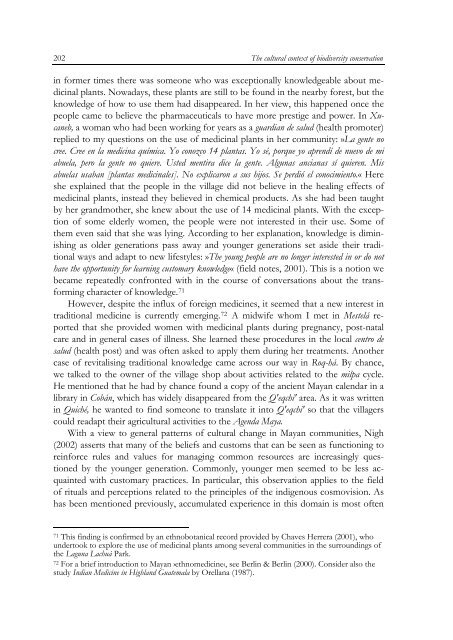The cultural context of biodiversity conservation - Oapen
The cultural context of biodiversity conservation - Oapen
The cultural context of biodiversity conservation - Oapen
You also want an ePaper? Increase the reach of your titles
YUMPU automatically turns print PDFs into web optimized ePapers that Google loves.
202<br />
<strong>The</strong> <strong>cultural</strong> <strong>context</strong> <strong>of</strong> <strong>biodiversity</strong> <strong>conservation</strong><br />
in former times there was someone who was exceptionally knowledgeable about medicinal<br />
plants. Nowadays, these plants are still to be found in the nearby forest, but the<br />
knowledge <strong>of</strong> how to use them had disappeared. In her view, this happened once the<br />
people came to believe the pharmaceuticals to have more prestige and power. In Xucaneb,<br />
a woman who had been working for years as a guardian de salud (health promoter)<br />
replied to my questions on the use <strong>of</strong> medicinal plants in her community: »La gente no<br />
cree. Cree en la medicina química. Yo conozco 14 plantas. Yo sé, porque yo aprendí de nuevo de mi<br />
abuela, pero la gente no quiere. Usted mentira dice la gente. Algunas ancianas sí quieren. Mis<br />
abuelas usaban [plantas medicinales]. No explicaron a sus hijos. Se perdió el conocimiento.« Here<br />
she explained that the people in the village did not believe in the healing effects <strong>of</strong><br />
medicinal plants, instead they believed in chemical products. As she had been taught<br />
by her grandmother, she knew about the use <strong>of</strong> 14 medicinal plants. With the exception<br />
<strong>of</strong> some elderly women, the people were not interested in their use. Some <strong>of</strong><br />
them even said that she was lying. According to her explanation, knowledge is diminishing<br />
as older generations pass away and younger generations set aside their traditional<br />
ways and adapt to new lifestyles: »<strong>The</strong> young people are no longer interested in or do not<br />
have the opportunity for learning customary knowledge« (field notes, 2001). This is a notion we<br />
became repeatedly confronted with in the course <strong>of</strong> conversations about the transforming<br />
character <strong>of</strong> knowledge. 71<br />
However, despite the influx <strong>of</strong> foreign medicines, it seemed that a new interest in<br />
traditional medicine is currently emerging. 72 A midwife whom I met in Mestelá reported<br />
that she provided women with medicinal plants during pregnancy, post-natal<br />
care and in general cases <strong>of</strong> illness. She learned these procedures in the local centro de<br />
salud (health post) and was <strong>of</strong>ten asked to apply them during her treatments. Another<br />
case <strong>of</strong> revitalising traditional knowledge came across our way in Roq-há. By chance,<br />
we talked to the owner <strong>of</strong> the village shop about activities related to the milpa cycle.<br />
He mentioned that he had by chance found a copy <strong>of</strong> the ancient Mayan calendar in a<br />
library in Cobán, which has widely disappeared from the Q'eqchi' area. As it was written<br />
in Quiché, he wanted to find someone to translate it into Q'eqchi' so that the villagers<br />
could readapt their agri<strong>cultural</strong> activities to the Agenda Maya.<br />
With a view to general patterns <strong>of</strong> <strong>cultural</strong> change in Mayan communities, Nigh<br />
(2002) asserts that many <strong>of</strong> the beliefs and customs that can be seen as functioning to<br />
reinforce rules and values for managing common resources are increasingly questioned<br />
by the younger generation. Commonly, younger men seemed to be less acquainted<br />
with customary practices. In particular, this observation applies to the field<br />
<strong>of</strong> rituals and perceptions related to the principles <strong>of</strong> the indigenous cosmovision. As<br />
has been mentioned previously, accumulated experience in this domain is most <strong>of</strong>ten<br />
71 This finding is confirmed by an ethnobotanical record provided by Chaves Herrera (2001), who<br />
undertook to explore the use <strong>of</strong> medicinal plants among several communities in the surroundings <strong>of</strong><br />
the Laguna Lachuá Park.<br />
72 For a brief introduction to Mayan ›ethnomedicine‹, see Berlin & Berlin (2000). Consider also the<br />
study Indian Medicine in Highland Guatemala by Orellana (1987).

















